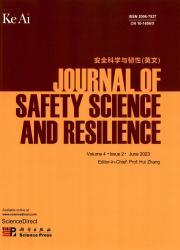DyHDGE: Dynamic heterogeneous transaction graph embedding for safety-centric fraud detection in financial scenarios
IF 3.4
Q1 PUBLIC, ENVIRONMENTAL & OCCUPATIONAL HEALTH
引用次数: 0
Abstract
Dynamic graph fraud detection aims to distinguish fraudulent entities that deviate significantly from most benign entities within an ever-changing graph network. However, when dealing with different financial fraud scenarios, existing methods face challenges, resulting in difficulty in effectively ensuring financial security. In fraud scenarios, transaction data are generated in real time, in which a strong temporal relationship between multiple fraudulent transactions is observed. Traditional dynamic graph models struggle to effectively balance the temporal features of nodes and spatial structural features, failing to handle different types of nodes in the graph network. In this study, to extract the temporal and structural information, we proposed a dynamic heterogeneous transaction graph embedding (DyHDGE) network based on a dynamic heterogeneous transaction graph, considering both temporal and structural information while incorporating heterogeneous data. To separately extract temporal relationships between transactions and spatial structural relationships between nodes, we used a heterogeneous temporal graph representation learning module and a temporal graph structure information extraction module. Additionally, we designed two loss functions to optimize node feature representations. Extensive experiments demonstrated that the proposed DyHDGE significantly outperformed previous state-of-the-art methods on two simulated datasets of financial fraud scenarios. This capability contributes to enhancing security in financial consumption scenarios.
DyHDGE:动态异构交易图嵌入,用于金融场景中以安全为中心的欺诈检测
动态图欺诈检测旨在区分在不断变化的图网络中明显偏离大多数良性实体的欺诈实体。然而,在处理不同的金融欺诈场景时,现有方法面临挑战,难以有效确保金融安全。在欺诈场景中,交易数据是实时生成的,其中可以观察到多个欺诈交易之间存在很强的时间关系。传统的动态图模型难以有效平衡节点的时间特征和空间结构特征,无法处理图网络中不同类型的节点。在本研究中,为了提取时间和结构信息,我们提出了一种基于动态异构交易图的动态异构交易图嵌入(DyHDGE)网络,在结合异构数据的同时考虑了时间和结构信息。为了分别提取交易之间的时间关系和节点之间的空间结构关系,我们使用了异构时间图表示学习模块和时间图结构信息提取模块。此外,我们还设计了两个损失函数来优化节点特征表示。广泛的实验表明,在两个金融欺诈场景的模拟数据集上,所提出的 DyHDGE 明显优于之前的先进方法。这种能力有助于提高金融消费场景的安全性。
本文章由计算机程序翻译,如有差异,请以英文原文为准。
求助全文
约1分钟内获得全文
求助全文
来源期刊

安全科学与韧性(英文)
Management Science and Operations Research, Safety, Risk, Reliability and Quality, Safety Research
CiteScore
8.70
自引率
0.00%
发文量
0
审稿时长
72 days
 求助内容:
求助内容: 应助结果提醒方式:
应助结果提醒方式:


